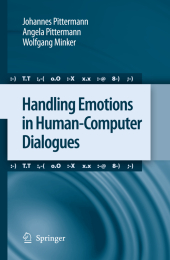 Neuerscheinungen 2014Stand: 2020-02-01 |
Schnellsuche
ISBN/Stichwort/Autor
|
Herderstraße 10
10625 Berlin
Tel.: 030 315 714 16
Fax 030 315 714 14
info@buchspektrum.de |

Wolfgang Minker, Angela Pittermann, Johannes Pittermann
(Beteiligte)
Handling Emotions in Human-Computer Dialogues
2010. 2014. x, 276 S. 235 mm
Verlag/Jahr: SPRINGER NETHERLANDS; SPRINGER 2014
ISBN: 9400791704 (9400791704)
Neue ISBN: 978-9400791701 (9789400791701)
Preis und Lieferzeit: Bitte klicken
This book presents novel methods to perform robust speech-based emotion recognition at low complexity. It describes a flexible dialogue model to conveniently integrate emotions and other dialogue-influencing parameters in human-computer interaction.
In this book, a novel approach that combines speech-based emotion recognition with adaptive human-computer dialogue modeling is described. With the robust recognition of emotions from speech signals as their goal, the authors analyze the effectiveness of using a plain emotion recognizer, a speech-emotion recognizer combining speech and emotion recognition, and multiple speech-emotion recognizers at the same time. The semi-stochastic dialogue model employed relates user emotion management to the corresponding dialogue interaction history and allows the device to adapt itself to the context, including altering the stylistic realization of its speech. This comprehensive volume begins by introducing spoken language dialogue systems and providing an overview of human emotions, theories, categorization and emotional speech. It moves on to cover the adaptive semi-stochastic dialogue model and the basic concepts of speech-emotion recognition. Finally, the authors show how speech-emotion recognizers can be optimized, and how an adaptive dialogue manager can be implemented. The book, with its novel methods to perform robust speech-based emotion recognition at low complexity, will be of interest to a variety of readers involved in human-computer interaction.
1. Introduction. 1.1 Spoken Language Dialogue Systems.1.2 Enhancing a Spoken Language Dialogue System.1.3 Challenges in Dialogue Management Development. 1.4 Issues in User Modeling. 1.5 Evaluation of Dialogue Systems. 1.6 Summary of Contributions.-
2. Human Emotions. 2.1 Definition of Emotion. 2.2 Theories of Emotion and Categorization. 2.3 Emotional Labeling. 2.4 Emotional Speech Databases/Corpora. 2.5 Discussion.-
3. Adaptive Human-Computer Dialogue.3.1 Background and Related Research. 3.2 User-State and Situation Management. 3.3 Dialogue Strategies and Control Parameters. 3.4 Integrating Speech Recognizer Confidence Measures into Adaptive Dialogue Management. 3.5 Integrating Emotions into Adaptive Dialogue Management. 3.6 A Semi-Stochastic Dialogue Model. 3.7 A Semi-Stochastic Combined Emotional. 3.8 A Semi-Stochastic Combined Emotional Dialogue Model. 3.9 Extending the Semi-Stochastic Combined Emotional Dialogue Model. 3.10 Discussion.-
4. Hybrid Approach to Speech-Emotion Recognition. 4.1 Signal Processing. 4.2 Classifiers for Emotion Recognition. 4.3 Existing Approaches to Emotion Recognition. 4.4 HMM-based Speech Recognition. 4.5 HMM-based Emotion Recognition. 4.6 Combined Speech and Emotion Recognition. 4.7 Emotion Recognition by Linguistic Analysis. 4.8 Discussion.-
5. Implementation. 5.1 Emotion Recognizer Optimizations. 5.2 Using Multiple (Speech-) Emotion Recognizers. 5.3 Implementation of our Dialogue Manager. 5.4 Discussion.-
6. Evaluation. 6.1 Description of Dialogue System Evaluation Paradigms. 6.2 Speech Data Used for the Emotion Recognizer Evaluation. 6.3 Performance of our Emotion Recognizer. 6.4 Evaluation of our Dialogue Manager. 6.5 Discussion.-
7. Conclusion and Future Directions.-
A. Emotional Speech Databases.-
B. Used Abbreviations.-
References.-
Index


